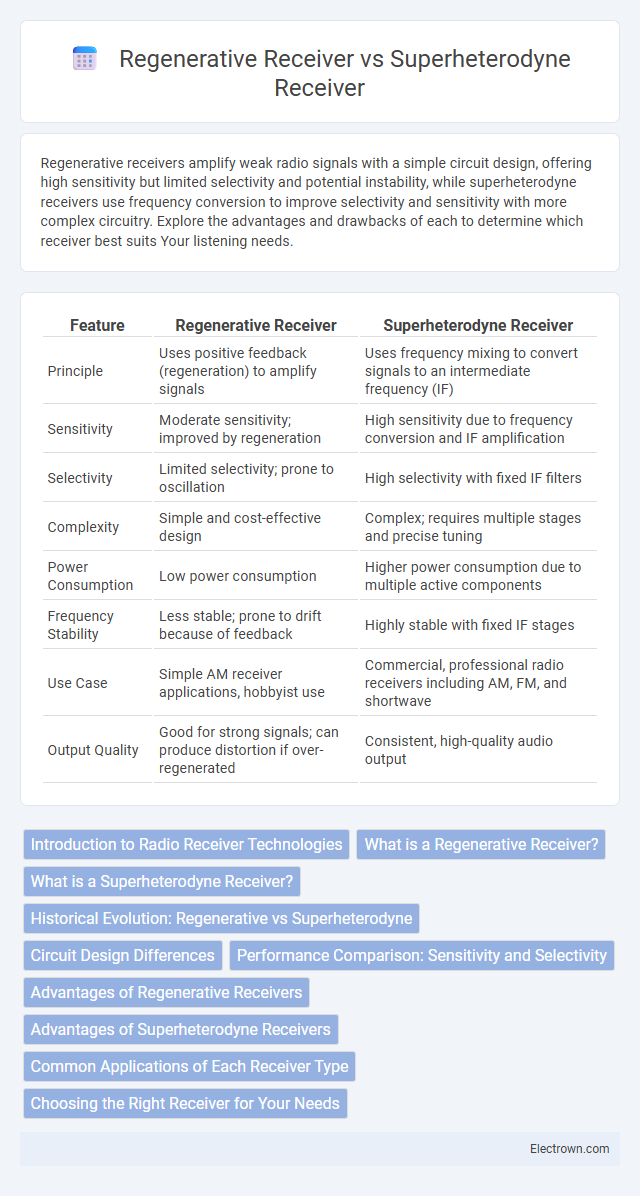Regenerative receivers amplify weak radio signals with a simple circuit design, offering high sensitivity but limited selectivity and potential instability, while superheterodyne receivers use frequency conversion to improve selectivity and sensitivity with more complex circuitry. Explore the advantages and drawbacks of each to determine which receiver best suits Your listening needs.
Table of Comparison
| Feature | Regenerative Receiver | Superheterodyne Receiver |
|---|---|---|
| Principle | Uses positive feedback (regeneration) to amplify signals | Uses frequency mixing to convert signals to an intermediate frequency (IF) |
| Sensitivity | Moderate sensitivity; improved by regeneration | High sensitivity due to frequency conversion and IF amplification |
| Selectivity | Limited selectivity; prone to oscillation | High selectivity with fixed IF filters |
| Complexity | Simple and cost-effective design | Complex; requires multiple stages and precise tuning |
| Power Consumption | Low power consumption | Higher power consumption due to multiple active components |
| Frequency Stability | Less stable; prone to drift because of feedback | Highly stable with fixed IF stages |
| Use Case | Simple AM receiver applications, hobbyist use | Commercial, professional radio receivers including AM, FM, and shortwave |
| Output Quality | Good for strong signals; can produce distortion if over-regenerated | Consistent, high-quality audio output |
Introduction to Radio Receiver Technologies
Regenerative receivers use positive feedback to amplify weak radio signals, offering simplicity and high sensitivity ideal for shortwave listening. Superheterodyne receivers convert incoming signals to a fixed intermediate frequency, enabling superior selectivity and stability across a wide range of frequencies. Your choice depends on whether you prioritize ease of construction with regenerative designs or advanced performance with superheterodyne technology.
What is a Regenerative Receiver?
A regenerative receiver is a type of radio receiver that uses positive feedback to amplify weak radio signals, enhancing sensitivity and selectivity. By feeding a portion of the output signal back into the input, it achieves higher gain with fewer components compared to other designs. Your experience with receiving distant or faint signals improves significantly, though these receivers may be prone to instability and interference without careful adjustment.
What is a Superheterodyne Receiver?
A Superheterodyne Receiver is a radio receiver that converts incoming radio frequency signals into a fixed intermediate frequency (IF) for easier and more selective processing. This design improves sensitivity and selectivity by allowing consistent amplification and filtering at the IF stage, distinguishing it from Regenerative Receivers that rely on feedback to boost weak signals. Your choice of a Superheterodyne Receiver ensures enhanced signal clarity and stability, especially in crowded radio environments.
Historical Evolution: Regenerative vs Superheterodyne
The regenerative receiver, invented by Edwin Armstrong in 1914, marked a significant advancement in early radio technology by amplifying weak signals through positive feedback, revolutionizing home listening experiences. The superheterodyne receiver, introduced during World War I by Armstrong as well, replaced the complexity of early designs with frequency conversion and intermediate frequency amplification, becoming the dominant architecture due to its superior selectivity and sensitivity. Understanding the historical evolution between these receivers highlights the shift from simple, cost-effective regeneration to the more complex, high-performance superheterodyne systems shaping modern radio communication.
Circuit Design Differences
Regenerative receivers utilize positive feedback within a single-tuned circuit to amplify weak signals and improve selectivity, resulting in a simpler, compact design with fewer components. Superheterodyne receivers incorporate multiple frequency conversion stages and intermediate frequency (IF) amplification, involving mixers, local oscillators, and IF filters, leading to enhanced sensitivity and selectivity at the cost of increased circuit complexity. The regenerative design offers ease of construction and low power consumption, whereas superheterodyne circuits provide superior performance in handling strong signals and frequency stability.
Performance Comparison: Sensitivity and Selectivity
Regenerative receivers exhibit high sensitivity due to their ability to amplify weak signals through positive feedback, making them ideal for low-power signal detection but often suffer from limited selectivity and potential instability. Superheterodyne receivers provide superior selectivity by converting received signals to an intermediate frequency (IF), allowing precise filtering and improved signal discrimination in crowded radio environments. While regenerative receivers excel in simplicity and sensitivity for basic applications, superheterodyne designs dominate in performance-critical scenarios requiring robust selectivity and consistent signal quality.
Advantages of Regenerative Receivers
Regenerative receivers offer superior sensitivity and selectivity with minimal components, making them ideal for low-cost and compact radio designs. Their ability to provide high gain through positive feedback reduces the need for multiple amplification stages. This simplicity and efficiency also result in lower power consumption compared to superheterodyne receivers.
Advantages of Superheterodyne Receivers
Superheterodyne receivers offer superior selectivity and sensitivity by converting incoming signals to a fixed intermediate frequency, enabling easier and more precise filtering. They minimize image frequency interference and provide consistent performance across a broad range of frequencies. These advantages make superheterodyne designs the standard choice for modern communication systems requiring reliable and high-quality signal reception.
Common Applications of Each Receiver Type
Regenerative receivers are commonly used in amateur radio, vintage radio collections, and educational projects due to their simplicity and sensitivity in receiving weak signals. Superheterodyne receivers dominate commercial broadcasting, television, and modern communication devices because of their superior selectivity, stability, and ability to handle multiple frequency bands. Both types serve distinct purposes, with regenerative receivers favored for low-cost, hobbyist use and superheterodyne receivers preferred in professional and high-performance applications.
Choosing the Right Receiver for Your Needs
Regenerative receivers excel in simplicity, low cost, and high sensitivity for amateur radio enthusiasts seeking to boost weak signals without complex circuitry. Superheterodyne receivers offer superior selectivity, stability, and versatility, making them ideal for professional applications requiring precise frequency tuning and interference rejection. Selecting the right receiver depends on your priorities: budget and ease of use favor regenerative models, while advanced performance demands point toward superheterodyne designs.
Regenerative Receiver vs Superheterodyne Receiver Infographic

 electrown.com
electrown.com